Blue Sapphires from Mogok, Myanmar: A Gemological Review

ABSTRACT
Burmese sapphires are among the most coveted colored gemstones in the world. The historical importance of this source and the fine quality of its high-grade material contribute to the legendary status of these gems. Since Mogok is such a long-known source, there are many classic studies available, but modern analytical data are often missing or not up to current standards. This article summarizes the characteristics of Burmese sapphires, including standard gemological properties, inclusion observations, and spectroscopic and trace element analyses. This information was collected from hundreds of blue sapphires that GIA’s field gemologists sampled while visiting different mining regions in Mogok over the past decade. Our observations indicate that these sapphires show a wide range of blue color intensities but very consistent inclusion scenes. Trace element chemistry did not show any significant differences between various regions apart from a wider range of Fe concentrations in sapphires from north of Mogok. Rare observations such as orange fluorescence and unusual FTIR spectra can be attributed to the chemical compositions of the sapphires.
Mogok is the most legendary gemstone source in Myanmar; its fabled rubies have been highly desired for centuries. Perhaps equally sought-after by connoisseurs but less known to the general public are its blue sapphires (figure 1). Mogok is one of the oldest sapphire sources, but its sapphires have always faced challenges in gemological circles. Their beauty was often not acknowledged in older days, but this changed dramatically in recent decades. In light of the increasing demand for origin determination services, separating blue sapphire sources has become important for gemological laboratories. Collecting reliable samples had been extremely challenging due to limited access to the mines and the rarity of blue sapphire in Mogok. This paper aims to summarize the current knowledge of Mogok sapphires based on extensive gemological analysis of samples collected during field expeditions in the last decade, combined with data available in the gemological literature.
INTRODUCTION TO MOGOK SAPPHIRES
Myanmar and Mogok. The Asian country of Myanmar, formerly known as Burma, is located on the crossroads between Southeast Asia, the Indian Subcontinent, and China. From 200 BCE to 800 CE, the land was controlled by a group of city-states, often referred to as the Pyu city-states. This state structure was replaced by a line of larger kingdoms after the Burmans drove out the Pyu in the ninth century. Among the earliest was the Pagan Kingdom, which laid the foundation for the nation that later became modern-day Myanmar. This can be seen as the foundation of the Burmese language and culture, including the adoption of Theravada Buddhism as the state religion. The ancient capital, now referred to as Bagan and designated as a UNESCO World Heritage Site, is one of the main tourism destinations in the country. This kingdom eventually fell to Mongol invasions, after which it took centuries to recover and reunify the nation under the Toungoo Dynasty in the mid-sixteenth century. In 1752, it was replaced by the Konbaung Dynasty, which continued the administrative reforms set out by the previous rulers. Initially, the Konbaung rulers tried to resist increasing pressure from European colonial powers. In 1885, after they lost the third Anglo-Burmese war, Burma was completely annexed into the British Empire.
The earliest writings from European explorers mentioned the close connection between the different Burmese empires and their vast gem resources (Hughes et al., 2017; Temple, 1928; Penzer, 1937). Later explorers with better-documented journals provided detailed firsthand accounts of the “markets stocked in rubies and sapphires” (d’Amato, 1833; Luard, 1926–1927). Evidently, the British colonists took great interest in all natural resources, including gemstones. During the annexation, large-scale operations were leased out to mining firms for the first time. These were most successful in the late 1890s and early 1900s. World War I shifted economic priorities, and the importance of gemstone mining subsided (Brown, 1927; Hughes et al., 2017). European control was only briefly interrupted during World War II when Japanese forces took control of Burma. Colonial rule lasted until 1948, when Burma gained its independence from the British Empire.
In 1962, only 14 years after the country gained its independence, the military regime took control of the state. The military junta, also referred to as Tatmadaw, changed the name of the country to Myanmar in 1989. They refused to give up their total power until 2011, when the ruling military party was reformed. However, the military kept tight control on the young democracy, and after the 2020 elections it once again took control of the country in a new coup d’état in February 2021.
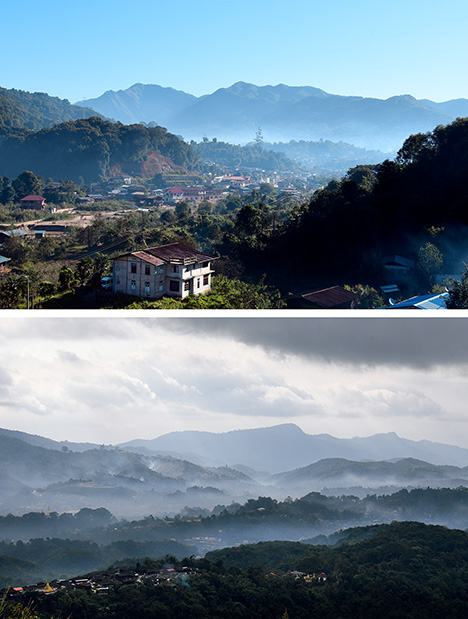
The Mogok region is located in central Myanmar, around 120 km northeast of Mandalay (figure 2). The area is located on the western side of the Shan Plateau and flanked by the Ayeyarwady (Irrawaddy) River to the west. The rugged terrain is characterized by steep hills and numerous streams cutting through. The main city is located at an elevation of 1100 m, but the surrounding mountains can reach nearly 2300 m. Due to high rainfall and warm summers, vegetation is abundant and the jungle quickly reclaims abandoned areas. During winter, the temperatures at higher elevations can dip below the freezing point.
The name “Mogok” is used to describe many things and can lead to some confusion. It is important to know which “Mogok” is being referred to. The town of Mogok is where much of the gem trading activity takes place and is near many of the historical gem mines. Mogok township is the administrative area comprising Mogok city, Kyatpin, and other surrounding towns. More than 170,000 people live in the township. The Mogok Stone Tract, a term introduced by the British administration, does include the Mogok township but stretches much farther north.
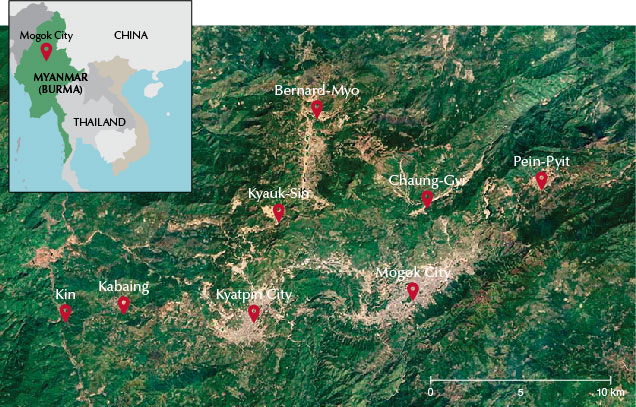
The Mogok administrative area consists of different settlements. Figure 3 covers the extent of the Mogok township and indicates some notable towns. The main population concentrations are in the cities of Mogok and Kyatpin, which lie in the heart of the gemstone mining areas. In the rest of this article, the term “Mogok” refers to the wider area, not exclusively to the town or a single mine.
Foreigners cannot visit freely and must have permission from the appropriate authorities and be accompanied by a government-approved guide at all times. Mogok has been subject to sudden closures and has always been difficult to enter. Even when all paperwork has been approved, permits can be retracted at the last minute.
Mogok Sapphire. While Mogok is commonly associated with rubies, its variety of gems is unmatched. Apart from ruby, the other important stones are spinel, sapphire, and peridot. Rare collector minerals such as painite and johachidolite have been discovered there. Mogok’s finest sapphires are of exceptional quality, and a Burmese origin is considered one of the most desired localities, surpassed only by Kashmir (Hughes et al., 2017). Today, Burmese sapphire is held in high esteem by the trade, but this was not always the case.
At the end of the nineteenth century, Burmese sapphires were considered too dark (Streeter, 1892). Only in the middle of the twentieth century did these stones acquire the reputation they hold today. Smith (1972) wrote that no other source produced sapphires as superb as Burma’s. Brown and Dey (1955) took a more modest approach: “It has been stated that Burmese sapphires as a whole are usually too dark for general approval, but this is quite incorrect; next to the Kashmir sapphires they are unsurpassed.”
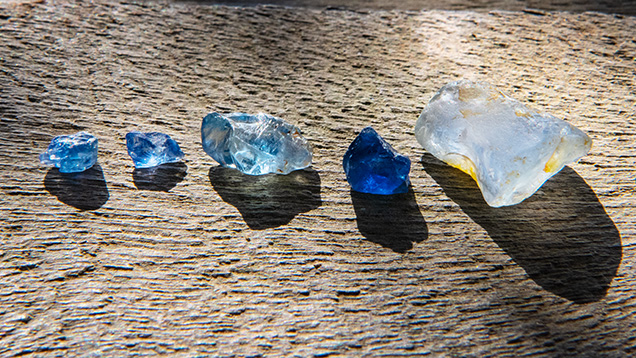
As with all origins, only some of the stones recovered have the desired color, size, and clarity, and thus origin is not synonymous with quality. The best Mogok sapphires have a saturated, rich, intense blue color, sometimes with a light violet component. But Mogok sapphires are by no means restricted to these typical rich blue colors. A wide range of tone and saturation in blue color is found, from pale icy blue and delicate periwinkle to dark navy blue (figure 4). Fine star sapphires have also been reported from the western area, near Kin (Hughes and Win, 1995). While Mogok rubies are much more common in the trade than their blue cousins, the size of Burmese sapphires is one of the reasons for their fame. Finished gems larger than 100 carats have been documented, and gray-blue corundum crystals weighing several kilograms have been recovered, although the latter were not facetable.
Blue sapphires are found all over the Mogok area, but the town of Pein-Pyit and the Chaung-Gyi Valley to the northeast of Mogok city in particular are known to produce a blue sapphire of various intensities and tones. The northern town of Bernard-Myo and the north-south trending valley it lies in have a thriving sapphire mining and trading scene next to the large peridot mines found in this area. The area to the west and northwest of Kyatpin, with main centers in Baw Mar and Kyauk-Sin, hosts some of the largest mines. Many smaller mines are in the Thurein-Thaung/Yadana-Kaday-Kadar area a bit farther south. Blue sapphires are also found on the Mogok Stone Tract’s western border in river gravels near the towns of Kin and Kabaing. The large secondary deposits in the lower parts of the valleys once held significant volumes of sapphire that washed down from the surrounding mountains, but most of these are now exhausted.

Sapphire dealers in Mogok pay very close attention to the source of the rough (figure 5). It is believed that sapphires from western Mogok maintain their rich blue color in various orientations, while those from the eastern parts may take a greenish tint when the c-axis is not precisely perpendicular to the table (Hughes and Win, 1995). Some sapphires from Bernard-Myo have a stronger violet component, making them too dark, or a strong green component (Halford-Watkins, 1935). However, these are anecdotal observations from traders, and some of these views can be quite dated. There have been no extensive studies to back them up.
GEOLOGY AND MINING OF THE MOGOK SAPPHIRE DEPOSITS
Regional Geology of Mogok. Due to limited access, complicated geological history, degree of weathering, and thick vegetation cover, the local geology of Mogok is not well understood. Only recently have advanced geological studies taken place, but they are focused on larger scale structures and not directly on gem-forming processes.

The area is part of the Mogok Metamorphic Belt, a geological feature that extends over 1500 km from the Andaman Sea in the south to the edge of the Eastern Himalayas in the north. Marbles metamorphosed under high amphibolite- and granulite-facies conditions are the dominant lithology in this belt, but a variety of high-grade metamorphic and intrusive rocks are found (figure 6).
In the Mogok and Kyatpin valleys, where gem minerals are most common, the marbles have been intruded by charnockite and syenite intrusions, forming sills. The center of the valley consists of this unit and stretches WSW-ENE, dipping to the south. Most intrusions are concordant with the marble layering (figure 6). While the exact age of the marble is unclear, it formed in the Tethys Ocean, which completely disappeared with the collision of the Indian Subcontinent with Asia (Iyer, 1953; Oo, 2011; Searle et al., 2007; Zahirovic et al., 2012). The syenite intrusions have been dated, but interpretation of these ages is not conclusive since some of them might have been reset in later stages. Most dates place the intrusions in the early Jurassic period (170–163 Ma), although others point to a younger age (67–22 Ma). These younger dates overlap with the intense metamorphism associated with the formation of the Himalayas and have probably been overprinted (Searle et al., 2020).
Field observations have determined the presence of several sills, with Taung-Met syenite being the most obvious with a thickness of 400 m. This intrusion is among the most resistant rocks and stands out in relief as the hill range north of Mogok and Kyatpin cities and includes the highest point in the Mogok area (Taung-Met-Taung Mountain; again, see figure 6). The syenite-charnockite rocks can have variable mineralogical components, but field observations suggested that the syenites, in combination with marbles and skarn, are more closely related to gem formation than the charnockites (Searle et al., 2020). Nevertheless, charnockites have been described as the source for sapphire and other gem mineralizations in Sri Lanka (Rupasinghe and Dissanayake, 1985).
The intrusions developed extensive calc-silicate skarns in the marble. The increased heat from the hot intrusions combined with the low Si-activity in them created the right conditions for corundum formation. It is in these skarn zones, limited to a structural distance of 1–2 km from the intrusion, that most rubies and sapphires are found. Field observations indicate that sapphire typically forms closer to the intrusions (Searle et al., 2020).
In the immediate vicinity of the intrusions, metasomatized zones form around them. This metasomatization results in the formation of mineralized zones that are often rich in mica but might also contain sodalite, lazurite, and others, depending on the local conditions (Searle et al., 2020).
This means that Mogok was subjected to a localized metamorphic event related to the intrusions of the charnockite-syenites, probably in the early Jurassic period. The entire region underwent granulite-facies metamorphism in the late Cretaceous to the early Miocene.
Intrusions of leucogranite and associated pegmatites that are most likely related to the large Kabaing granite intrusion to the west are also found (Gardiner et al., 2014, 2016; Iyer, 1953; Themelis, 2008). These are also related to gem mineralization but are more likely the source of pegmatite-related gemstones (topaz, aquamarine, etc.) that appear to be more common toward the west of Mogok. These intrusions are much younger and only intruded after peak metamorphic conditions passed (22–18 Ma) (Searle et al., 2020). In western Mogok, they overlap alongside the older syenite intrusions, but their interaction might have triggered the formation of new minerals.
Toward the north, there is a large ultramafic body. There is still an ongoing debate whether this intruded during later metamorphism or represents an ophiolitic mantle rock (Searle et al., 2017; Thu, 2007).
Geology of Mogok Sapphire Deposits. While ruby and spinel from Mogok formed in relatively pure marbles, the formation of sapphire is less understood and likely more complicated (Garnier et al., 2008). Most studies agree that the intrusions played a significant role in the formation of blue corundum in Mogok. Still, there is little clarity whether these intrusions are directly responsible for sapphire mineralization or are just one of the factors that played a role. Field observations have shown a strong link between the distribution of gem corundum and the syenite/charnockite intrusions, although the gems themselves only formed during later metamorphism (Searle et al., 2020). Many of the intrusions were Si-poor, which meant that they had the capacity to leach silicon from the host rocks, leaving an environment enriched in aluminum, which is required for corundum formation. The reverse process can also occur, where silicon is removed from the intrusion by the host rock. This way, the intrusion can be desilicated and relatively enriched in Al, thus forming a suitable environment for corundum. This rock is sometimes referred to as plumasite (Giuliani et al., 2014). Some studies found strong indicators that the sapphires found in the syenite intrusions might be xenocrysts. In other words, they did not form in the syenitic magma but rather were picked up and brought to the surface (Turnier and Harlow, 2017). Given the complex geology of the Mogok gem area, we cannot exclude the possibility that there are multiple types of sapphire-forming processes responsible for its wealth of blue sapphire.
While the geological formation of Mogok sapphire is not yet fully understood, it is obviously unrelated to alkali basalt extrusions. Some of the richest sapphire deposits on our planet are associated with basalts, and these gems are often referred to as basaltic or magmatic. Typical localities are Thailand, Nigeria, and Australia. They share similar gemological and mineralogical characteristics, which sets them apart from the second group of sapphires, known as metamorphic. These metamorphic sapphires are found mainly in Sri Lanka and Madagascar, as well as Mogok. While the geological formation of these sources is not well understood, they do share sufficient spectroscopic and gemological similarities to group them together. These similarities make it challenging to determine the exact geographic origin of metamorphic sapphires.
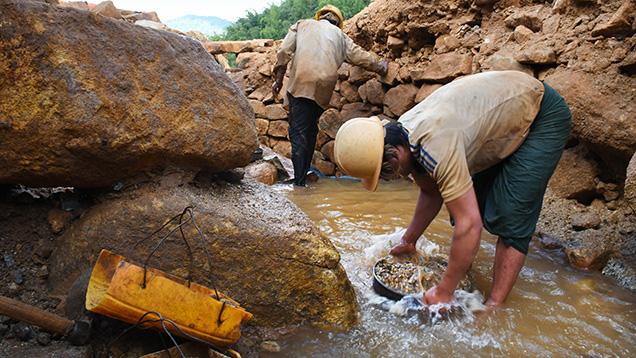
Mining Techniques. Mogok’s sapphires are mainly mined in secondary deposits. In these deposits, crystals have been released from the host rock. Due to various processes, often related to transport in water, the heaviest minerals are concentrated. This concentrate is called byon in Myanmar and contains a mixture of several minerals, including corundum, spinel, tourmaline, and topaz, depending on the location (figure 7).

Gemstone mining has a long tradition in Mogok, and several mining methods are used for sapphire (Hughes et al., 2017). The first type is called twin-lon, where a narrow shaft is sunk into the ground to reach the byon. Once the byon is reached, horizontal tunnels branch out to remove as much valuable material as possible. This system is comparable to traditional gem mining in many parts of the world, although the scale is often smaller. Since flooding is a serious risk, this method is often limited to the dry season. The second type is the hmyaw-dwin method, a form of hillside open-pit mining (figure 8). Water is used to loosen up and wash away mud and light minerals, leaving behind heavier crystals such as corundum and spinel. This concentrate is then washed. Since this technique uses a lot of water, it is preferred in the wet season.
Cave mining, or lu-dwin, is also common in Mogok but is mainly used for spinel and ruby since they form directly in the marble that hosts the caves. Sapphire formation is not directly linked to the marble formation; as a result, the blue gems are much less common in cave deposits.
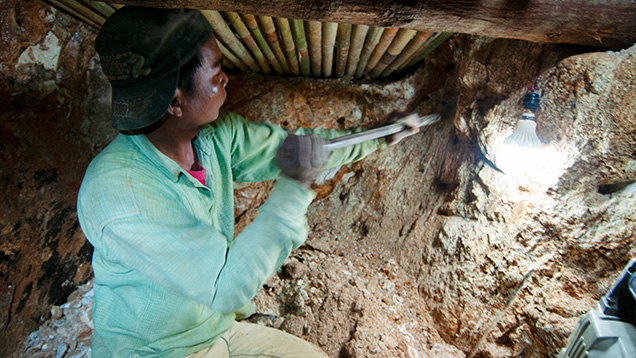
Hard-rock mining has become more common in Mogok since most of the secondary deposits are becoming exhausted. Several sapphire mining operations have switched to this technique, although they are not comparable in size with the massive ruby operations that work primary deposits in deep tunnels. This method follows gem-rich zones through the rock and excavates them. Explosives are often required to blast through the rock in the ruby mines, but most sapphire-hosting rocks are so weathered that the gems can be removed manually, without the use of heavy equipment (figure 9). The gem-rich rocks are brought to the surface and further processed to release the gems from their matrix. Even the largest operations working in the primary deposits rely heavily on manual labor in places where gems are more abundant. Removal of overburden or barren rock is often done with heavy equipment such as excavators.
MATERIALS AND METHODS
Blue sapphires included in this study were collected from different areas in the Mogok Stone Tract by GIA field gemologists during expeditions between 2014 and 2019 (figure 10). The stones were separated into groups based on their mining area. This should allow us to see any variations based on location and to potentially test claims made by traders. While this selection covers most of the important areas, we acknowledge that not every sapphire mine in Mogok is represented. Nevertheless, all areas that are locally known to produce significant quantities of gem-quality sapphire are included in this study.

A total of 248 Mogok samples were separated into six groups based on geographic mining location in the Mogok Stone Tract area (figure 3): 21 from North (Bernard-Myo area), 32 from Northeast (Chaung-Gyi Valley), 22 from East (Pein-Pyit village and Hta-Yan-Sho mine), 83 from Northwest (Baw Mar and Kyauk-Sin mines), 40 from West (Yadanar-Kaday-Kadar, Thurein-Thaung, Man-Taw-Tin, Kyauk-Tya-That, and Baw-Lon-Gyi mines, located between Kabaing and Kyatpin), and 50 from Far West (Kin Valley) (table 1).
These samples were studied in three forms: 230 rough samples with one or more polished surface windows, to focus on inclusions; 12 optical wafer samples with a set of parallel polished surface windows oriented either perpendicular or parallel to the crystal’s c-axis (Thomas, 2009); and six faceted samples.
Standard gemological properties such as refractive index (RI), birefringence, and hydrostatic specific gravity (SG) were measured on all samples. A standard gemological UV lamp with long-wave (LW) and short-wave (SW) radiation at 365 and 254 nm, respectively, was used for fluorescence observations. Microscopic examination was performed with GIA binocular microscopes at 10× to 70× magnification, using various lighting including darkfield, brightfield, diffused, and fiber-optic illumination. Photomicrographs were captured with Nikon SMZ 18 and 1500 systems at different magnifications and lighting.
Ultraviolet/visible/near-infrared (UV-Vis-NIR) spectra were collected on the 12 optical wafer samples with a Hitachi U-2900 spectrophotometer specially modified at GIA to include a rotatable polarizer to allow the separate collection of the ordinary (o-) and extraordinary (e-) rays at a wavelength resolution of 1.5 nm. Fourier-transform infrared (FTIR) spectra were measured on all 248 samples using a Thermo Nicolet 6700 FTIR spectrometer operating with a 4× beam condenser accessory at a resolution of 4 cm–1. A Renishaw inVia Raman microscope fitted with a 514 nm argon-ion laser was used to identify mineral inclusions, when possible. This was also used for photoluminescence (PL) analysis with a 457 nm laser excitation at room temperature.
Trace element chemical analyses were performed on all samples using laser ablation–inductively coupled plasma–mass spectrometry (LA-ICP-MS) technology with a Thermo Fisher Scientific iCAP Q ICP-MS coupled with a Q-switched Nd:YAG laser ablation device operating at a wavelength of 213 nm. The laser conditions used were 55 μm diameter laser spots with a fluence of approximately 10 J/cm2 and a repetition rate of 10 Hz. The dwell time of each spot was 40 s. The forward power was set at 1350 W, and the typical nebulizer gas flow was approximately at 0.80 L/min. A special set of corundum reference standards was used for quantitative analysis of Be, Mg, Ti, V, Cr, Fe, and Ga (Stone-Sundberg et al., 2017), whereas NIST Standard Reference Materials 610 and 612 glasses were used for other elements. All elemental measurements were normalized on Al as the internal elemental standard.
RESULTS AND DISCUSSION

Gemological Properties and Appearance. Generally, sapphires produced from various areas in the Mogok Stone Tract have a range of blue color from light to strong saturation (figure 11). The standard gemological properties of the studied materials are typical of natural corundum: RI of 1.760–1.770, birefringence of 0.008–0.009, and hydrostatic SG of 3.81–4.04.

Viewed under a standard gemological UV lamp (365 and 254 nm), the vast majority of Mogok blue sapphires in this study (81%) showed no fluorescence under long-wave UV radiation, while 10% fluoresced red (without zoned orange fluorescence). The remainder displayed zoned orange fluorescence (with very weak or no red fluorescence) in near-colorless to light blue color zones. The fluorescence intensity under long-wave UV was generally weak to moderate. It should be noted that the red and orange fluorescence observed in these blue sapphires is caused by different defects (figure 12) and can appear together when observed with a gemological UV lamp. Orange fluorescence is relatively common in metamorphic blue sapphire from other sources, such as Sri Lanka and Madagascar (Hughes et al., 2017). In figure 12, a stone with red fluorescence showed R-line emission at 693.0 and 694.4 nm that is caused by Cr3+. The orange fluorescent region displayed an additional emission band at around 640 nm that is related to trapped hole chromophores (Hughes et al., 2017). In natural corundum, the reaction under long-wave UV is generally stronger than that in short-wave UV. This was confirmed in the studied Mogok sapphires, which were all inert under short-wave UV light.

The graph in figure 13 shows the observed fluorescence color under long-wave UV for Mogok sapphires in six different regions. Among the studied samples, blue sapphires from the West and East areas showed the highest percentage (40%) displaying a fluorescent reaction. Among the samples with observable fluorescence, the North samples displayed only red fluorescence, whereas the samples from other areas exhibited both red and orange zoned fluorescence.


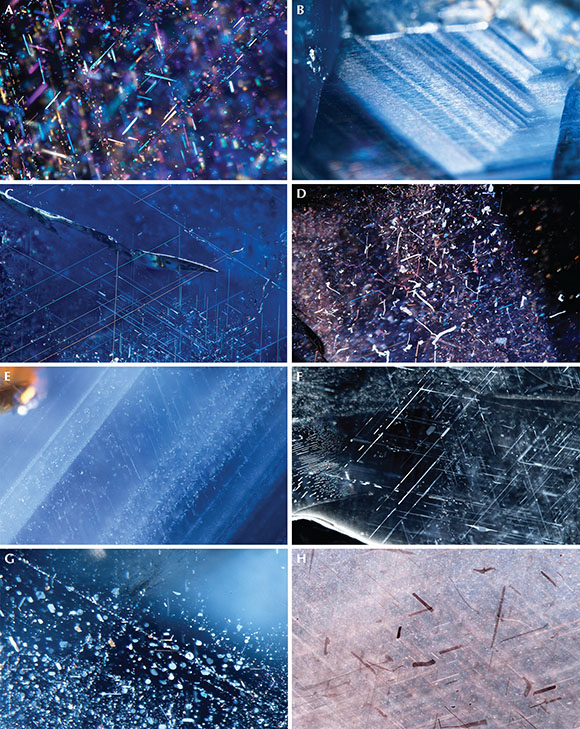
Microscopic Observation. The studied samples from the Mogok Stone Tract area presented similar internal features and exhibited many inclusions commonly seen in classic Mogok blue sapphires reported previously (Gübelin and Koivula, 2008; Hughes et al., 2017; Themelis, 2008), as summarized in table 2. Figure 14 illustrates the distribution of internal features commonly observed in the studied Mogok sapphires separated by mining locations. The most common inclusion types are rutile needles/silk; they were observed in more than 80% of the samples. Silk can occur in various patterns, often overlapping with those of other metamorphic deposits, such as Sri Lanka and Madagascar (Palke et al., 2019). They can consist of densely packed short needles, a mix of short and long needles in zones or discrete bands, and sometimes arrowhead patterns (figure 15, A–C). Mogok sapphires can also have irregular/flaky iridescent platelets, presumably ilmenite (Kan-Nyunt et al., 2013), bands/zones of coarse particles with short needles, and rounded/elongated reflective platelets (figure 15, D–G). When oblique fiber-optic light is reflected from the surface of the silk, the needles/platelets exhibit iridescent colors (e.g., figure 15, A and D, and figure 16, left). Using other lighting conditions, the rutile silk commonly appeared whitish (e.g., figure 15, B and G), while irregular/flaky platelets generally look brownish (e.g., figures 15H and 16, right). Irregular brownish platelets (presumably ilmenite) are noticeably seen in the sapphires containing high iron (Fe) content (>800 ppma Fe).


Other frequently observed features are polysynthetic twin planes on the rhombohedron and growth tubes along twin planes. Twinning is usually present as multiple planes, sometimes intersecting in the samples (figures 14 and 17, left). Rose channels (growth tubes at twin intersections) are occasionally filled by boehmite/diaspore (figure 17, right) (Notari et al., 2018).
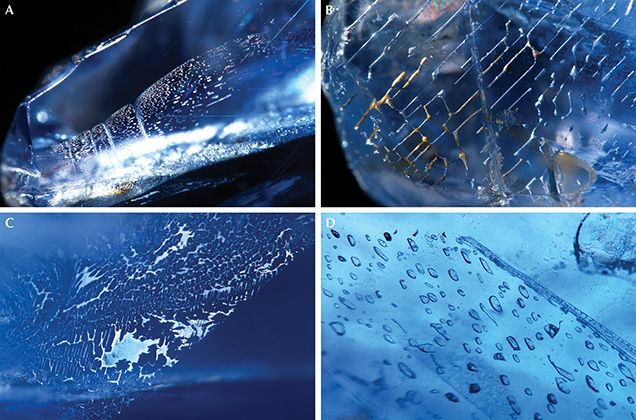

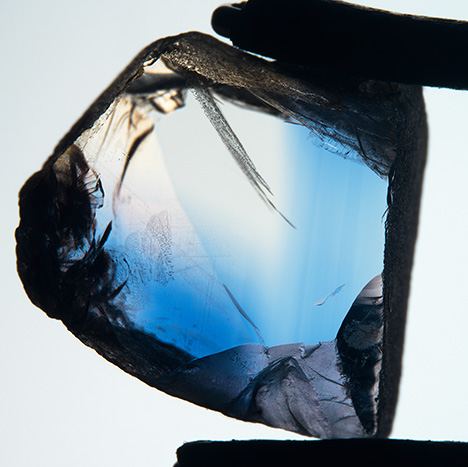
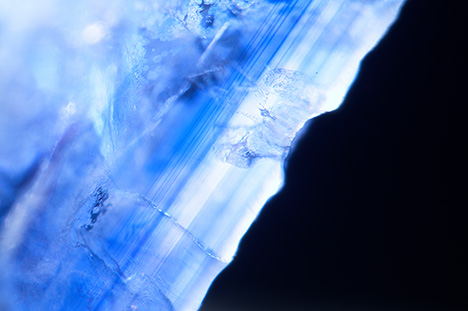
In Mogok sapphires, healed fissures or fingerprints can be present in various ways, such as folded, coarse, zig-zag fluid, and fingerprints where individual negative crystals are easily recognized (figure 18, A–D). In addition, the blue sapphires from Mogok sometimes contain large negative crystals surrounded by iridescent fluid thin films (“rosettes”) (figure 19) (Raynaud and Vertriest, 2017). Mogok sapphires typically have an even blue color. However, in a small percentage (approximately 10%) of the studied samples, diffused blue color zoning lacking sharp boundaries can be observed (figure 20). Color zoning with sharp, well-defined boundaries can sometimes be seen, though rare (figure 21). Only three out of 248 samples in this study—from the East, Northeast, and Northwest areas—display straight and sharp blue bands.
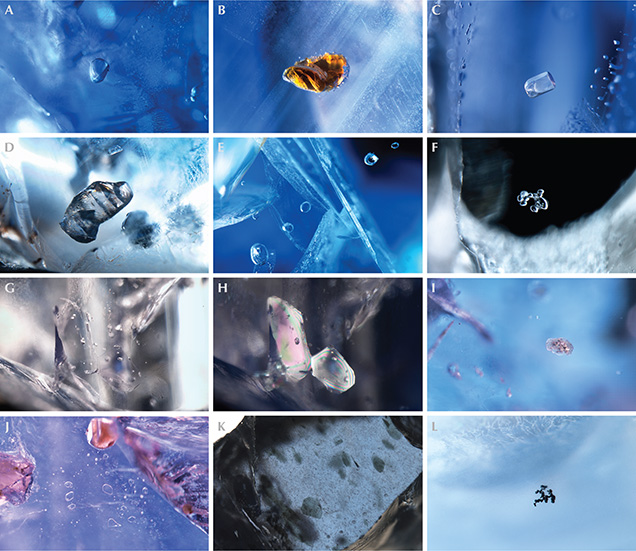

Multiple mineral crystals were found in the Mogok sapphires (table 2), but they are not diagnostic evidence for Burmese origin. In this study, apatite, calcite, corundum, feldspar, mica, monazite, nepheline, rutile, scapolite, spinel, and zircon, as well as green sheets and tiny opaque black crystals were observed and identified (figure 22). Most of these mineral crystals, except for scapolite, are reported in previous studies for blue sapphires (Gübelin and Koivula, 2008; Themelis, 2008; Kan-Nyunt et al., 2013; Saengbuangamlam et al., 2016; Hughes et al., 2017). Scapolite inclusions have been identified in Burmese rubies (Kammerling et al., 1994), and to our knowledge this is the first reporting of scapolite in Burmese sapphires. The occurrence of specific mineral inclusions in Mogok sapphires identified by Raman spectroscopy is summarized in figure 23, with feldspar and mica being the most common.

Infrared (IR) Absorption Spectroscopy. The infrared absorption region of interest in corundum is approximately 1800–4000 cm–1, which is related to hydroxyl (OH) absorption. IR spectroscopic information can help detect heat treatment in corundum, such as the presence of a series of sharp peaks at approximately 3309, 3232, 3187, and 3368 cm–1 (Smith, 1995), and also reveal the presence of several OH-related mineral inclusions. The vast majority of Mogok samples in the study (>90%) showed at least one diagnostic IR feature (figure 24): the single 3309 cm–1 peak (Beran and Rossman, 2006), the 3161 cm–1 peak sometimes associated with side bands at 2420, 3240, and 3355 cm–1 (Smith and Van der Bogert, 2006), and some OH-related mineral absorption features, such as diaspore, boehmite, kaolinite, and gibbsite (Smith, 1995; Beran and Rossman, 2006).

Figure 25 shows the distribution of FTIR features observed in samples from each region in the Mogok Stone Tract. Mineral features were observed in more than 80% of the samples from all regions. The single 3309 cm–1 peak is present in the samples from each area, whereas the 3161 cm–1 feature can be found in a small percentage (<5%) of Northeast, East, Northwest, and Far West samples. We noted that the studied sapphires exhibiting the 3161 cm–1 IR feature frequently show orange zoned fluorescence, which is related to trapped-hole defects (as mentioned in the Gemological Properties and Appearance section).


UV-Vis-NIR Absorption Spectroscopy. All spectral-quality samples from the Mogok Stone Tract exhibited similar UV-Vis-NIR spectra, as shown in figure 26. The spectra generally consist of Fe3+-related absorption features with a shoulder at 330 nm and peaks at 377, 388, and 450 nm, and also a Fe2+-Ti4+ intervalence charge-transfer feature with a broad band centered at 580 nm in the o-ray or at 700 nm in the e-ray spectrum (Dubinsky et al., 2020). Sometimes, the shoulder at 330 nm of an Fe3+-Fe3+ pair is not observed due to the samples’ relatively high Fe concentration (Dubinsky et al., 2020). The spectra shown in figure 26A are typical of the metamorphic-type sapphire spectrum (Smith, 2010; Palke et al., 2019). Some high-Fe Mogok sapphires show a weak broad absorption band in the near-infrared region around 880 nm in addition to Fe3+ and Fe2+-Ti4+ absorption features in the UV-Vis region (figure 26B). This feature is common in basalt-related sapphires but not typically associated with untreated classic metamorphic sapphires (Kan-Nyunt et al., 2013; Soonthorntantikul et al., 2017). This 880 nm absorption band is possibly related to Fe clusters (Hughes et al., 2017).
Spectroscopic characteristics of Mogok blue sapphires in this study were also summarized in table 3.

Trace Element Chemistry. LA-ICP-MS data analyzed in inclusion-free and/or less particle-included areas for the studied Mogok blue sapphires are reported in table 4. Significant levels of Mg, Fe, Ti, and Ga with a few ppma of V and Cr were measured in those samples (see also Peucat et al., 2007; Kan-Nyunt et al., 2013; Atikarnsakul et al., 2018). The overall data exhibited a wide range of Fe concentrations from 100 ppma to 2300 ppma. The Mg and Ti concentrations can vary a lot depending on the presence of microinclusions (nanometers to nearly millimeters in size), with big differences between the inclusion-free and the cloudy areas. Significant amounts of Ga, typically observed in natural corundum, were also detected in all samples in this study. Apart from those six elements, some other elements, including Be, Zr, Nb, Sn, Hf, Ta, W, and Th, are sometimes present with very low concentrations when analyzed on areas containing particles. Traces of Be can be present in natural untreated sapphires in cloudy areas with a high particle density, and it is frequently associated with Nb, Ta, light rare earth elements, and/or Th (Shen et al., 2007; Lu and Shen, 2011). In the studied samples, the concentrations of natural Be range from about <0.5 to 2.6 ppma; Zr, Nb, Sn, Hf, Ta, W, and Th are generally below detection limits, and they can be measured in quantities of up to 0.5 ppma Zr, 0.8 ppma Nb, 7 ppma Sn, 0.02 ppma Hf, 4 ppma Ta, 9 ppma W, and 0.5 ppma Th.


Trace element concentration distributions in Mogok sapphires from different regions are shown in figures 27 and 28 for Fe and Cr, respectively. Samples from the North, Northeast, East, and Northwest frequently had relatively high Fe content compared to those from the West and Far West areas (figure 27). All regions generally showed little to no Cr concentrations (figure 28), which corresponds with the lack of fluorescence generally observed in the samples (figure 13).
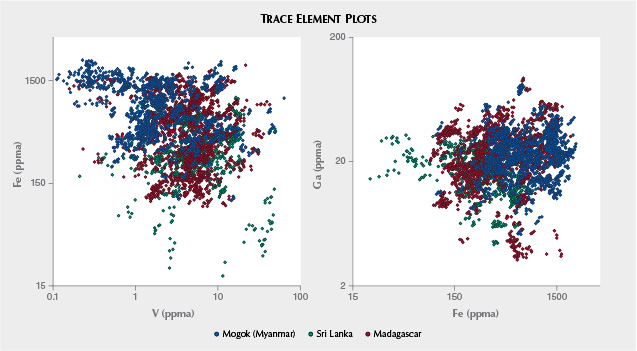
Mogok sapphires are part of the metamorphic group, which also includes Sri Lanka, Madagascar, and Kashmir, as well as some lesser-known sources. Comparing trace element chemistry of Mogok sapphires with the other two major deposits (Sri Lanka and Madagascar) reveals a significant overlap between these sources (figure 29). In some cases, trace element profiles can support reliable origin determination, but this type of data is seldom conclusive, even after advanced statistical data analysis. Origin determination of metamorphic sapphires still relies heavily on the inclusion scene (see Palke et al., 2019).
CONCLUSIONS
Mogok is among the classic and most coveted sources of sapphires, which means their properties have been studied for ages. This article attempts to summarize the characteristics of these magnificent blue gems based on samples collected by GIA field gemologists during more than 10 expeditions to the Mogok area in Myanmar.
The geology of the Mogok sapphire deposits is still not well understood. Still, in recent years many studies on the geology of Mogok and the overall genetic processes of sapphires are rapidly leading to new insights into the formation of gem-quality corundum mineralization.
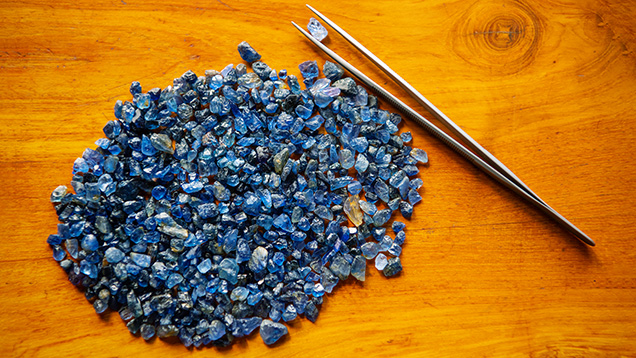
A detailed gemological study showed that blue sapphires from Mogok can vary from very pale to very saturated blue colors (figure 30). While most of the stones are inert under UV light, some show red fluorescence related to trace amounts of chromium, and a small fraction show zoned orange fluorescence linked to trapped holes in the corundum structure.
Inclusion scenes are similar in sapphires from different regions of the Mogok Valley, with silk in many forms being the main internal feature. Although crystal inclusions are relatively uncommon, mica and feldspar are most commonly encountered. A variety of other minerals were also detected, but they were much rarer. Scapolite is one of those rare inclusions, and this study is the first to report its presence in Mogok blue sapphires. The crystal inclusions are not conclusive for determining geographic origin. The appearance of silk, twin planes, and fingerprints can indicate the Burmese origin of a sapphire.
Color zoning was observed in only 10% of the samples. Burmese sapphires show a very diffuse transition from blue to colorless zones. Only a few samples in our study showed some sharp blue-colorless color zoning.
FTIR spectra are typically dominated by mineral features such as kaolinite and gibbsite. UV-Vis-NIR spectra are dominated by bands related to Fe2+-Ti4+ intervalence charge transfer and other peaks associated with Fe3+ species. In some stones with higher Fe concentrations, a small broad band is present at 880 nm, which is not commonly associated with untreated metamorphic sapphires.
Trace element chemistry revealed a wide range of Fe concentrations, although the maximum values were much higher in the sapphires from the eastern part of Mogok than those from western Mogok. Chromium concentrations were very low, and stones with an increased Cr content typically showed a slightly altered color (violetish tint) and red fluorescence. Natural beryllium can be detected in Burmese sapphires, but it is always measured in particle-rich areas.



